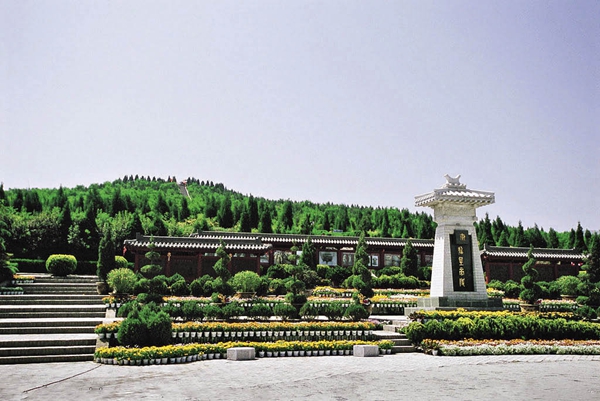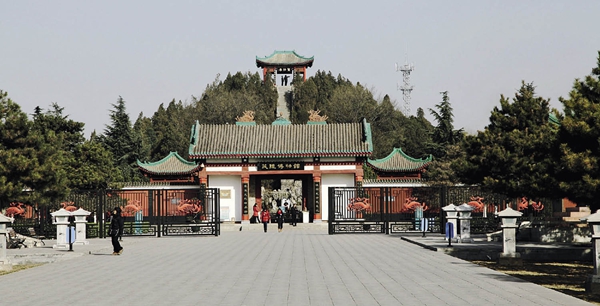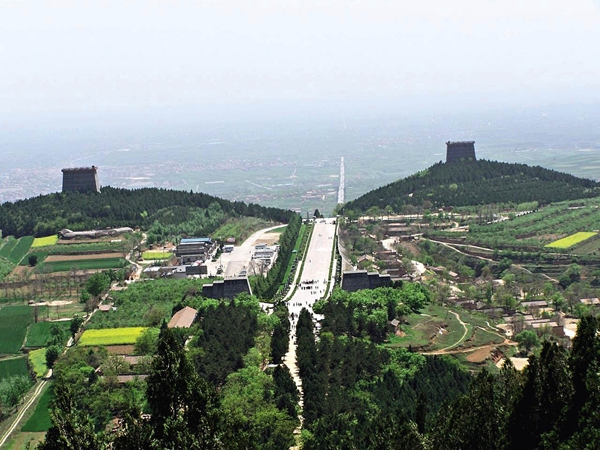The Mausoleum of the First Qin Emperor
Not merely the largest imperial mausoleum in China, the tomb of the First Qin Emperor nestles at the northern foot of Mount Lishan some 30 km east of Xi’an. Its construction lasted 38 years, and two concentric walls ring the tomb’s tumulus. The existing tomb mound is in the form of a conical frustum, whose base measures 515 meters from north to south, and 485 meters from east to west, the top of which soars to a height of 55 meters. For a multiplicity of reasons, the tomb has not as yet been excavated.

Another of the tomb’s attractions is its terracotta army, extolled as the eighth wonder of the world, which consists of life-sized terracotta warriors, their ranks standing in a battle array that engenders an awe-inspiring effect. Unsolved mysteries still swirl about the terracotta army. For example, the warriors’ weapons were preserved from rust by a protective chrome coating. That such electroplating-like techniques existed in China 2,000 years ago is mind-boggling given the presumptive lack of electricity at that time.
Transportation: Visitors can take No. 306 tour bus from the east square of Xi’an Railway Station to the mausoleum.
Maoling Mausoleum
Maoling is the tomb of Liu Che (156-87 BC), Emperor Wudi of Han. Han greatly prospered under his reign. He dispatched envoys to build up relations with kingdoms in the western regions and wrested control of the Hexi Corridor, thereafter successfully opening up the Silk Road and thus accessing trade with Central Asia and beyond.

Maoling features an imposing architectural style and extravagant funerary relics. It is the largest of all tombs built during the Han Dynasty and required the longest time for its construction. Visitors to the Maoling Museum may see the most completely preserved group of old stone inscriptions.
The tombs of imperial retainers cluster around Maoling. Among these, the most famous is the Tomb of Huo Qubing, a famous young general. He commanded troops by age 18 when he followed his uncle Wei Qing to combat the Huns. He died at the untimely age of just 24. To commemorate his brilliant military service, Emperor Wudi had the tomb built for him and ordered the carving of decorative stone figures for its embellishment.
Transportation: Visitors can first take a long-distance bus to Xingping City from Xi’an West Passenger Depot, then transfer to the No. 11 bus to the Maoling Museum.
Qianling Mausoleum
Located at the foot of Mount Liangshan, 85 km northwest of Xi’an, Qianling is the only tomb in China for two rulers – Emperor Gaozong and his wife Wu Zetian. The tomb is divided into an inner necropolis and outer necropolis, with gates on its four sides and a total circumference of about 40 km.

The existing relics above the ground include 114 stone carved figures in the form of horses, humans, winged horses, ornamental columns and ostriches, as well as a stele that records the achievement of Emperor Gaozong, with a corresponding but blank tablet for Wu Zetian. The wordless tablet is made of a huge rock with eight entwined dragons carved on the top. Today, this wordless tablet has become a symbol for not only the Qianling Mausoleum, but also the woman who became empress, Wu Zetian.
Transportation: Visitors can take the No. 3 tour bus from the east square of Xi’an Railway Station to the Qianling Mausoleum.
Huaqing Palace
Located 30 km east of Xi’an, the Huaqing Palace sits adjacent to the terracotta army. Emperors of various dynasties constructed palaces and gardens in the region. According to historical records, every winter from 745 to 755, Emperor Xuanzong brought Yang Yuhuan and some trusted followers there to escape the cold, and they returned to Chang’an each late spring following. During that period, the emperor dealt with state affairs and met with foreign representatives in Huaqing Palace, which accordingly became a political center at that time.

Today, there are iconic architectural features in Huaqing Palace, including the museum of imperial bathing pools of the Tang Dynasty, the former site of the Xi’an Incident and the museum of ruins of Pear Garden of the Tang Dynasty (Pear Garden, or Liyuan, was the first known royal acting and musical academy in China). The palace features pleasant scenery: hot spring pools lie at its center, surrounded by pavilions, terraces and towers. Moreover, visitors can appreciate the beautiful love story between Xuanzong and Yang Yuhuan by watching the dance drama – Song of Everlasting Sorrow – which is staged there every evening.
Transportation: Visitors can take 306 tour bus from the east square of Xi’an Railway Station and alight at the Huaqing Pool Station.
Daming Palace National Heritage Park
Daming was the imperial palace complex of the Tang Dynasty, and was therefore a political center and symbol of the country at that time. Originally named Yong’an, meaning perpetual stability, its construction started in 634. It was the largest among the three major Tang palaces in Chang’an. After the reign of Gaozong, it served as the seat for 17 Tang emperors to administer state affairs for more than 200 years.
The architectural style of Daming Palace has influenced the design and construction of many palaces in various East Asian countries. Daming Palace covered an area of 350 hectares, 4.5-fold the size of the Forbidden City in Beijing. It was burnt down in 896.
Transportation: Take the following buses: No. 2, No. 262, No. 528, No. 717 and No. 723 from the downtown area and alight at the Daming Palace Danfeng Gate Station.
(Compiled and edited by China Today)
